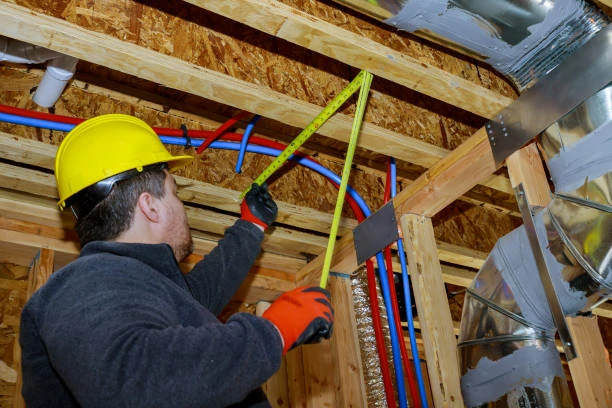1. Introduction to PEX Plumbing Pipes
PEX plumbing pipes have become a preferred option in modern plumbing. Made from cross-linked polyethylene, they offer excellent flexibility and durability. PEX pipe come in various sizes, including 1/2-inch, 3/4-inch, and 1-inch. They cater to different plumbing needs, such as residential or commercial applications. For example, 1/2-inch PEX pipes are commonly used for household water supply. PEX’s flexibility allows it to curve around corners, reducing the need for fittings. It resists scale buildup and corrosion, providing long-lasting performance. PEX pipes are suitable for both hot and cold water systems. With a lifespan of up to 50 years, they offer a cost-effective plumbing solution for many homeowners.
2. Key Features of PEX Plumbing Pipes
PEX pipe have several advantages over traditional materials like copper or PVC. Their flexibility speeds up the installation process and reduces labor costs. PEX resists freezing and bursting in cold temperatures, which is especially important in colder climates. It can expand and contract without cracking. Its smooth interior reduces friction, promoting better water flow. PEX pipes are also highly resistant to chlorine and other chemicals found in water. Unlike metal pipes, they do not corrode or develop leaks. Moreover, PEX pipes are quieter than metal, which reduces water hammer noise. These benefits make PEX an excellent choice for modern plumbing systems.
3. Applications of PEX Plumbing Pipes
PEX pipes are versatile and suitable for many applications. In residential settings, they are ideal for both hot and cold water supply systems. For example, 3/4-inch PEX pipes are often used for main water lines. In radiant floor heating systems, PEX’s flexibility allows easy installation and efficiency. In commercial buildings, PEX is widely used for distributing hot and cold water. Its chemical resistance makes it perfect for industrial applications. PEX pipes are also commonly used in fire sprinkler systems. The material’s adaptability and durability make PEX an excellent choice for diverse plumbing needs.
4. Installation and Maintenance of PEX Plumbing Pipes
PEX pipe installation requires specific tools and techniques. A PEX cutter ensures clean and precise cuts for easy connections. Crimp rings, clamps, or push-fit fittings are used to secure the pipes. Crimp rings create tight, leak-proof connections that last. PEX pipes are flexible, making them easier to route around obstacles without extra fittings. For maintenance, regularly inspect for leaks or damage. Annual checks on fittings and connections help avoid issues. Flushing the system removes any debris, maintaining water flow efficiency. Proper installation and ongoing care will maximize the lifespan of your PEX plumbing system.
5. Why Choose PEX Plumbing Pipes?
PEX plumbing pipes offer numerous advantages for modern plumbing systems. Their flexibility makes installation easier in tight spaces and reduces the need for joints. PEX pipes resist freezing, corrosion, and damage from chemicals, ensuring longevity. They are quieter than metal pipes, reducing water hammer sounds. PEX improves water flow efficiency, helping reduce energy costs. With minimal maintenance, PEX pipes last up to 50 years. They are both cost-effective and eco-friendly compared to traditional materials. For residential and commercial applications, PEX pipes provide a reliable, efficient solution. Choose PEX for its durability, flexibility, and long-term performance.
Global Standards for PEX Pipes
PEX pipes adhere to various international standards, each offering specific technical requirements to ensure safety and performance. Some of the key standards include ISO 15875, GB/T 18992, DIN 16892, and ASTM F877. ISO 15875 is the international standard for PEX pipes used in hot and cold water systems. It outlines performance criteria such as pressure ratings, temperature limits, and material properties. GB/T 18992 sets the specifications for PEX pipes specifically used within China, addressing local requirements like pipe sizes and fittings.
DIN 16892 applies to the German market and provides detailed guidance on the design, installation, and performance of PEX systems. ASTM F877 and F2788 are used in the United States and govern the standards for PEX pipes used in both residential and commercial applications, including water distribution and radiant heating systems. In the United Kingdom, BS 7291 and BS EN ISO 15875 outline the performance standards and installation guidelines for PEX pipes. Finally, CSA B137 sets the standard for PEX pipes in Canada, ensuring they meet specific technical and safety regulations for use in plumbing and heating systems.
These various standards ensure global consistency in PEX pipe quality, performance, and safety, making it easier for manufacturers, installers, and consumers to trust the reliability of PEX piping systems across different regions. Adherence to these standards guarantees that PEX systems meet specific criteria for installation, pressure, temperature, and material performance, ensuring long-term durability and efficient functioning.
Contact
nectarplus is a professional manufacturer with 30 years of experience, dedicated to producing high-quality plastic pipes, fittings, and valves. Our products include brass valves, PPR valves, as well as various pipes and fittings to meet different customer needs. Whether you need plumbing and drainage pipes or valve products. nectarplus can provide a diverse range of high-quality, cost-effective products to support your projects. Below is our contact information.
We will reply your email or fax within 24 hours.
You can call us at any time if there is any question on our production.
Pls Mailto: [email protected]

